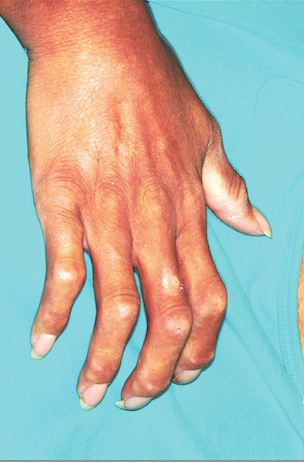ANSWER
Although this woman may end up having to see all of these specialists, she first needs confirmation of the suspected diagnosis: CREST syndrome, considered a variant of systemic sclerosis (aka scleroderma) and a condition marked by sclerotic transformation of virtually all the organs in and on the body. For more on this condition, see below.
The definitive diagnosis and expert management of this condition are generally considered the province of the rheumatologist, so choice “d” is the correct answer. Any of the other specialists, who often become involved in such cases early on, could likely identify this condition but would defer to rheumatology for definitive diagnosis and management.
DISCUSSION/TREATMENT
Systemic sclerosis (SSc) patients, like those with other rare conditions with protean manifestations, often go through long periods in which they see various specialists for each subset of symptoms—with a delay in arriving at a definitive, unifying diagnosis. This is a good example of the role played in such cases by dermatology, which is often able to “connect the dots” in patients with disparate complaints. Biopsy in such patients, for example, will show increased collagen deposition (among other changes), leading to heightened suspicion and confirmation by specific blood tests and expert clinical corroboration.
SSc affects approximately two million to 10 million people, almost four times as many women as men, and very few Asian patients. There are several variants of the condition, including cases of CREST in which skin changes are limited to the hands and face for decades before internal organs begin to be affected (if ever).
The CREST acronym stands for calcinosis (the scaly foci on our patient’s fingers), Raynaud’s phenomenon, esophageal dysmotility (due to collagen infiltration), sclerodactyly (sclerosis of finger skin), and telangiectasias (often on face and chest). CREST often starts, as in this case, with chronic edema of the hands, which gives way eventually to sclerodactyly and often to reabsorption of the bony tufts on distal digits. Dyschromia, particularly of the hands (as in this patient), is another common finding. SSc can also present with generalized pruritus.
SSc has a poor prognosis, progressing steadily as it begins to affect the lungs, liver, kidneys, and joints. Despite treatment, death may occur (most commonly from renal or respiratory failure).

